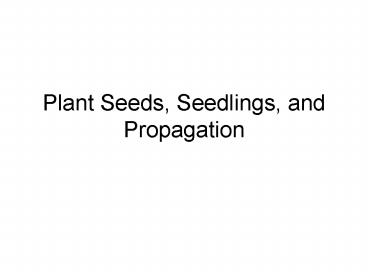Plant Seeds, Seedlings, and Propagation - PowerPoint PPT Presentation
1 / 25
Title:
Plant Seeds, Seedlings, and Propagation
Description:
Radicle - Stem tip developing into a root. Seen once germination has taken place. ... The radicle is encased in the coleorhiza. Seeds are Unique Individuals ... – PowerPoint PPT presentation
Number of Views:906
Avg rating:3.0/5.0
Title: Plant Seeds, Seedlings, and Propagation
1
Plant Seeds, Seedlings, and Propagation
2
Where do plants come from?
- Sexual reproduction
- Fruit and seeds
- Asexual reproduction
- Cuttings
- Runners
- Suckers
3
What is a Seed?
- A seed is a PLANT inside a BOX with its LUNCH
4
- Seeds
- Seed coat
- Protection
- Often hard and dry
- Embryo
- Plumule
- Epicotyl
- Hypocotyl
- Cotyledon
- Source of nutrition
- First seed leaves
- Begin photosynthesis
5
Seedlings
- Once the seed has germinated the same 4
structures become more visible - Cotyledons - Food storage organs that function as
first seed leaves. - Epicotyl - Stem above cotyledon. Seen once
germination has taken place. - Hypocotyl - Stem below attachment point. Seen
once germination has taken place. - Radicle - Stem tip developing into a root. Seen
once germination has taken place.
6
Beans and Peas belong to Dicotyledons
7
- Cotyledons do not play a significant role
- Endosperm is the source of nutrition
- Plumule is encased in a coleoptile
- The radicle is encased in the coleorhiza
Corn belongs to the Monocotyledons
8
(No Transcript)
9
Seeds are Unique Individuals
- Seeds are the product of sexual reproduction
- Each individual is genetically unique
- Advantage New combinations of traits
- Disadvantage high variability
- favorable in nature
- Unfavorable for agriculture and horticulture
10
Germination
- Germination is the beginning of seed growth.
- Seed must be viable.
- Some require period of dormancy.
- Brought about by either mechanical or
physiological circumstances - Tough hard seed coats prevent water absorption
- Some require Scarification
- Some fruits produce chemical inhibitors of
germination
11
Scarification
- In nature wind, water, gravel, rocks, the
elements scarify seeds - Repeated cycles of heat and cold
- Woody plants of temperate areas
- Fire
- Bacteria
12
Growth inhibiting substances
- Apples, pears, citrus fruits, tomatoes
- Contain inhibiting substances that prevent the
seed from germinating within the fruit
13
Germination Favorable Environmental Factors
- Imbibe water
- Water activates enzymes that convert starch to
sugar, proteins to amino acids - Presence of oxygen
- Waterlogged seeds wont germinate
- Presence or absence of light
- Varies with the kind of plant
14
Longevity
- Viability of most seeds is significantly extended
when the seeds are stored under conditions of low
temperatures and kept dry. - A few species produce seeds with no period of
dormancy.
15
Seed Banks
- Seed Banks (in Nature)
- Are everywhere!
- Seeds remain buried in the soil until favorable
environmental conditions allow germination - Germplasm Banks
- USDA stores seeds of every crop variety possible
- National Plant Germplasm System
- http//www.ars-grin.gov/npgs/
- For research
- To prevent extinction or loss of genes
16
National Germplasm Repositories(500,000 seeds
representing 8,000 species)
Urbana, Ill. Corn Germplasm
Aberdeen, Idaho National Small Grains Collection
17
Woody Landscape Plant Germplasm
Repository Collection, Maintenance, and
Evaluation
18
Asexual Plant Propagation
- Plants have the ability to produce clones of
themselves - Clones are genetically identical individuals
- Advantage More of the same is great if the plant
is healthy and grown in the same environment - Disadvantage Bad traits are passed on too. ie
lack of resistance to pests. - Asexual reproduction is a strategy that is used
by plants in nature as well as in Horticulture
19
Plant Propagation
- Crown division in Lilies
- This group of plant represent one clone
- Each section contains stem and root material
- Separating them by allows them to reproduce
further
20
Plant Propagation
- Cuttings (Horticulture)
- Propagules (Nature)
- Sources leaves, roots, stems
- Wound healing (from the cutting)
- Development of new organs
- Must be kept moist!
21
- Tip Layering (Horticulture)
- Suckering (Nature)
- A branch (stem) is bent over until it touches the
ground - Covered with soil
- New roots develop from the stem
22
Specialized Stems
- Specialized stems
- Bulbs
- Corms
- Tubers
- Rhizomes
- Potatoes are specialized stems called tubers
23
Micropropagation
- Growing plants in a sterile environment (lab)
- Can grow large of plants in a small area
- Explant piece of stem or leaf tissue
24
Micropropagation
- Tissue is grown in a petri dish
- Agar
- Nutrients
- Growth hormones
- Shoot formation
- Microshoots form
- Subculturing to another medium
- Theoretically millions of plants can be grown
from a single tissue sample
25
Micropropagation
- Commercial micropropagation is performed
successfully with - Orchids
- Boston Ferns
- African violets
- Hostas
- Apple root stocks help meet market demand
- Many ornamental woody plants
- Endangered species































